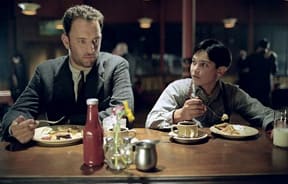The film-making process is not a spontaneous one. Too much money, planning, effort and care goes into the process to allow for much leeway in the way of "happy accidents," but "Road To Perdition" is a film so carefully considered, so meticulously worked over that while its attendant elements are often beautiful, remarkable and stunning, its whole doesn't quite surpass its well-structured parts. The film is being considered an important summer release for several reasons. It's the second film directed by British filmmaker (and theatre director) Sam Mendes, whose 1999 film "American Beauty" won him a Best Director Oscar. It's the first starring role in two years for Tom Hanks; it's also one of the first times that the American film icon tackles a character with seriously villainous qualities. It gathers a remarkable supporting cast in Paul Newman, Jude Law, Jennifer Jason Leigh and Stanley Tucci, and its cinematography, set design and score are all of the calibre that screams for awards. But for all its gathered talent and a story, based on a graphic novel, that weighs heavily with thematic resonance and symbolism, from its very title "Road To Perdition" lacks the delight and surprise of discovery that has marked the work of many of the gathered players.
Set in the 1930s, "Perdition" follows the story of Michael Sullivan (Hanks), a man who supports his family as a hit man for a noted mobster, the man who practically raised him, John Rooney (Newman). Sullivan has stoically accepted his fate and the fact that he's good at his job and enjoys its benefits while encouraging his two sons to follow a different life path. A series of unfortunate events that shouldn't be revealed here takes Sullivan and his eldest son on the road literally to the Illinois town of Perdition, figuratively into its namesake hell.
Much has been made of Hanks' "evil" role, but the film shies away from truly vilifying him in a number of ways. Although his past deeds are carefully outlined Sullivan carries with him a heavy burden of guilt his actions within the film take on a more paternal role: to protect his family and his relationship with his pseudo-father Rooney. Hanks is never shown actually performing any acts of violence in the film it's always artfully constructed to separate his acts from the frame of the camera. At times, it's beautiful, almost balletic, but Sullivan ostensibly remains the hero of the piece, never challenging the audience's expectations or unnerving their support for his path.
It's beautifully photographed, down to the sheen of the waxed floors and the dripping water from an iced-down coffin at a wake. Its set design and art direction is impeccably thought out down to the last frayed lace of period detail. Its score is at times understated, at others operatic. And it leaves you with a feeling that you should like this film more than you did it seems designed to impress, like a well-trained magician who has nary a surprise, even an awkward one, to offer.
Set in the 1930s, "Perdition" follows the story of Michael Sullivan (Hanks), a man who supports his family as a hit man for a noted mobster, the man who practically raised him, John Rooney (Newman). Sullivan has stoically accepted his fate and the fact that he's good at his job and enjoys its benefits while encouraging his two sons to follow a different life path. A series of unfortunate events that shouldn't be revealed here takes Sullivan and his eldest son on the road literally to the Illinois town of Perdition, figuratively into its namesake hell.
Much has been made of Hanks' "evil" role, but the film shies away from truly vilifying him in a number of ways. Although his past deeds are carefully outlined Sullivan carries with him a heavy burden of guilt his actions within the film take on a more paternal role: to protect his family and his relationship with his pseudo-father Rooney. Hanks is never shown actually performing any acts of violence in the film it's always artfully constructed to separate his acts from the frame of the camera. At times, it's beautiful, almost balletic, but Sullivan ostensibly remains the hero of the piece, never challenging the audience's expectations or unnerving their support for his path.
It's beautifully photographed, down to the sheen of the waxed floors and the dripping water from an iced-down coffin at a wake. Its set design and art direction is impeccably thought out down to the last frayed lace of period detail. Its score is at times understated, at others operatic. And it leaves you with a feeling that you should like this film more than you did it seems designed to impress, like a well-trained magician who has nary a surprise, even an awkward one, to offer.
